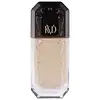What's inside
What's inside
 Key Ingredients
Key Ingredients

 Benefits
Benefits

 Concerns
Concerns

 Ingredients Side-by-side
Ingredients Side-by-side

Water
Skin ConditioningDimethicone
EmollientIsododecane
EmollientTrimethylsiloxysilicate
EmollientGlycerin
HumectantCetyl PEG/PPG-10/1 Dimethicone
EmulsifyingPyrus Malus Fruit Extract
Skin ConditioningCydonia Oblonga Leaf Extract
Skin ConditioningEthylhexylglycerin
Skin ConditioningPhenoxyethanol
PreservativeDimethicone Crosspolymer
Emulsion StabilisingSilica
AbrasiveSodium Chloride
MaskingDimethicone/Vinyl Dimethicone Crosspolymer
Skin ConditioningMagnesium Sulfate
Triethoxycaprylylsilane
Sodium Dehydroacetate
PreservativeDisteardimonium Hectorite
StabilisingBenzoic Acid
MaskingC24-28 Alkyl Methicone
EmollientDehydroacetic Acid
PreservativePropylene Carbonate
SolventPotassium Sorbate
PreservativeCitric Acid
BufferingSodium Benzoate
MaskingPentaerythrityl Tetra-Di-T-Butyl Hydroxyhydrocinnamate
AntioxidantTocopherol
AntioxidantAluminum Hydroxide
EmollientIron Oxides
Titanium Dioxide
Cosmetic ColorantWater, Dimethicone, Isododecane, Trimethylsiloxysilicate, Glycerin, Cetyl PEG/PPG-10/1 Dimethicone, Pyrus Malus Fruit Extract, Cydonia Oblonga Leaf Extract, Ethylhexylglycerin, Phenoxyethanol, Dimethicone Crosspolymer, Silica, Sodium Chloride, Dimethicone/Vinyl Dimethicone Crosspolymer, Magnesium Sulfate, Triethoxycaprylylsilane, Sodium Dehydroacetate, Disteardimonium Hectorite, Benzoic Acid, C24-28 Alkyl Methicone, Dehydroacetic Acid, Propylene Carbonate, Potassium Sorbate, Citric Acid, Sodium Benzoate, Pentaerythrityl Tetra-Di-T-Butyl Hydroxyhydrocinnamate, Tocopherol, Aluminum Hydroxide, Iron Oxides, Titanium Dioxide
Water
Skin ConditioningEthylhexyl Methoxycinnamate
UV AbsorberDisiloxane
Skin ConditioningPEG-30 Dipolyhydroxystearate
EmulsifyingEthylhexyl Salicylate
UV AbsorberC12-15 Alkyl Benzoate
AntimicrobialEthylhexyl Palmitate
EmollientGlycerin
HumectantIsohexadecane
EmollientCyclopentasiloxane
EmollientMethicone
EmollientPPG-15 Stearyl Ether
EmollientIsopropyl Titanium Triisostearate
EmollientBoron Nitride
AbsorbentJojoba Esters
EmollientSqualane
EmollientMagnesium Stearate
Cosmetic ColorantPentaerythrityl Tetra-Di-T-Butyl Hydroxyhydrocinnamate
AntioxidantDisodium EDTA
Tocopheryl Acetate
AntioxidantLauryl PCA
HumectantDipotassium Glycyrrhizate
HumectantPhenoxyethanol
PreservativeSodium Dehydroacetate
PreservativeMethylparaben
PreservativePropylparaben
PreservativeIron Oxides
CI 77891
Cosmetic ColorantWater, Ethylhexyl Methoxycinnamate, Disiloxane, PEG-30 Dipolyhydroxystearate, Ethylhexyl Salicylate, C12-15 Alkyl Benzoate, Ethylhexyl Palmitate, Glycerin, Isohexadecane, Cyclopentasiloxane, Methicone, PPG-15 Stearyl Ether, Isopropyl Titanium Triisostearate, Boron Nitride, Jojoba Esters, Squalane, Magnesium Stearate, Pentaerythrityl Tetra-Di-T-Butyl Hydroxyhydrocinnamate, Disodium EDTA, Tocopheryl Acetate, Lauryl PCA, Dipotassium Glycyrrhizate, Phenoxyethanol, Sodium Dehydroacetate, Methylparaben, Propylparaben, Iron Oxides, CI 77891
Ingredients Explained
These ingredients are found in both products.
Ingredients higher up in an ingredient list are typically present in a larger amount.
Glycerin is already naturally found in your skin. It helps moisturize and protect your skin.
A study from 2016 found glycerin to be more effective as a humectant than AHAs and hyaluronic acid.
As a humectant, it helps the skin stay hydrated by pulling moisture to your skin. The low molecular weight of glycerin allows it to pull moisture into the deeper layers of your skin.
Hydrated skin improves your skin barrier; Your skin barrier helps protect against irritants and bacteria.
Glycerin has also been found to have antimicrobial and antiviral properties. Due to these properties, glycerin is often used in wound and burn treatments.
In cosmetics, glycerin is usually derived from plants such as soybean or palm. However, it can also be sourced from animals, such as tallow or animal fat.
This ingredient is organic, colorless, odorless, and non-toxic.
Glycerin is the name for this ingredient in American English. British English uses Glycerol/Glycerine.
Learn more about GlycerinPentaerythrityl Tetra-Di-T-Butyl Hydroxyhydrocinnamate (long name, huh?) is a synthetic antioxidant.
It is used to help stabilize other antioxidants or prevent the color from changing in a product.
As an antioxidant, it helps fight free-radical molecules. Free-radical molecules are capable of damaging our cells and other genetic material. Thus, antioxidants may reduce the signs of aging.
This ingredient is oil-soluble.
Learn more about Pentaerythrityl Tetra-Di-T-Butyl HydroxyhydrocinnamatePhenoxyethanol is a preservative that has germicide, antimicrobial, and aromatic properties. Studies show that phenoxyethanol can prevent microbial growth. By itself, it has a scent that is similar to that of a rose.
It's often used in formulations along with Caprylyl Glycol to preserve the shelf life of products.
This ingredient is a preservative with antimicrobial properties. It is the sodium salt of dehydroacetic acid.
It is especially effective at preventing bacterial and fungal growth in low concentrations.
Water. It's the most common cosmetic ingredient of all. You'll usually see it at the top of ingredient lists, meaning that it makes up the largest part of the product.
So why is it so popular? Water most often acts as a solvent - this means that it helps dissolve other ingredients into the formulation.
You'll also recognize water as that liquid we all need to stay alive. If you see this, drink a glass of water. Stay hydrated!
Learn more about WaterThis ingredient is a combination of red, black, and yellow iron oxide pigments. This combination of colors is usually found in foundation, because it results in a "skin" color.